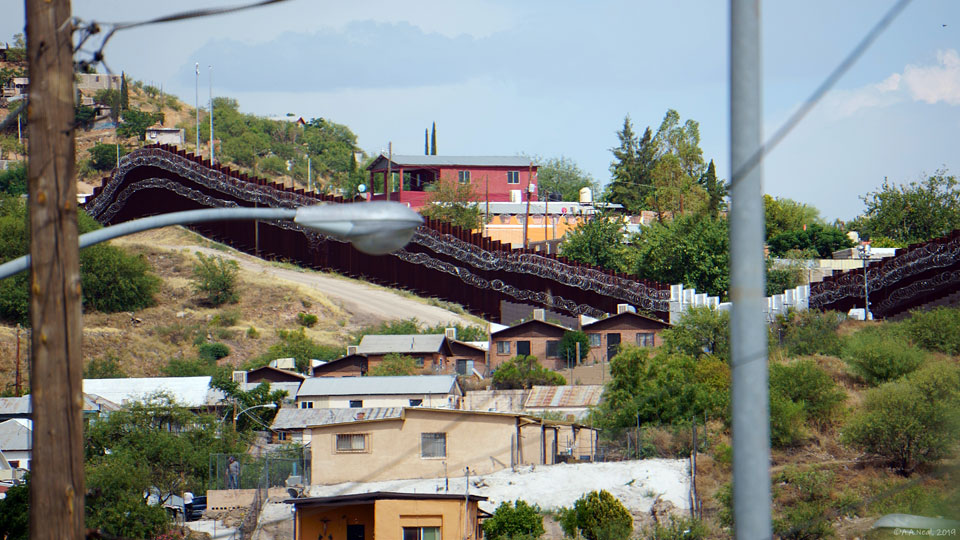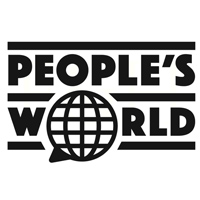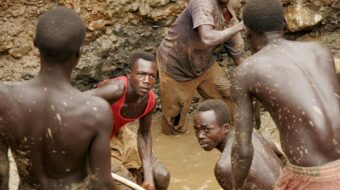
This article is part of the People’s World “On the Border Series,” which won a first place prize in the Best Series category at the 2020 Labor Media Awards, presented by the International Labor Communications Association.
“Give me your tired, your poor, your huddled masses yearning to breathe free. The wretched refuse of your teeming shore. Send these, the homeless, tempest-tossed to me, I lift my lamp beside the golden door.” – Statue of Liberty inscription, written by Emma Lazarus
Roughly a year ago, the American public became aware of the Trump admiration’s cruel policy—announcement followed by denial, followed by a second announcement—of separating migrant children from their parents at the southern border.
The public and media outrage gave way to other pressing topics. Since then, the situation at our southern border has worsened for migrants (refugees).
A slew of lawsuits and the resignations of Department of Homeland Security officials has further complicated the crisis, leading to a confused and weary public easily taken advantage of by the White House, as Trump implements an ever-growing number of inhumane policies.
And while Trump supposedly ended 2018’s “zero tolerance” and family separation policy, his administration used technical legal loopholes to quietly continue the policy.
At least 700 more families have been separated since then, and at least five children have died while in Customs and Border Patrol custody. Others, like Óscar Alberto Martínez Ramírez and his 23-month-old daughter, Valeria, die while trying to cross the border. They drowned attempting to swim the Rio Grande. They hoped to apply for asylum in the U.S. at a legal entry point but were denied and forced to take a more dangerous way into the U.S.

The conditions migrant children find themselves in after forceful separation from their families is unspeakable. Recent reports show they lack basic hygiene products—toothbrushes and soap. They’re usually found sleeping in cages covered in lice, never fully resting while sprawled out on concrete floors with fluorescent lights on 24 hours a day.
“The conditions within which they are held could be compared to torture facilities,” wrote Dr. Dolly Lucio Sevier, in her medical declaration after visiting a child detention center in Clint, Texas.
But, with all the noise surrounding this crisis, it is important to remember that these separated families are fleeing war, military and gang violence, repression, and poverty in their home countries. Undertaking a dangerous journey to seek asylum in the U.S. is no small matter, but the alternative at home is often worse.
In the month of July, People’s World will bring our readers coverage from all along the southern U.S. border. Our reporter Al Neal will be visiting towns and detention centers in an effort to correct media misconceptions of the refugee crisis and bring you a front-line view of the what’s really happening.
With a renewed focus on the migrant refugee crisis, here’s a guide to some of the big questions involved.
Why are the people of Central American countries fleeing their homes?
The quick answer: U.S. foreign policy in Latin America combined with repressive and corrupt local elites who impose crushing economic conditions.
The U.S. has a long and dark record of political and military intervention in the Caribbean and Central America which has created and/or worsened the instability and inequality at the root of the current refugee crisis.
From the end of the Spanish-American War in 1898, the U.S. military regularly intervened in a number of countries’ internal affairs on behalf of U.S. corporations. Its actions on behalf of U.S. produce companies, for instance, were such a common occurrence that those decades later became known as the “Banana Wars.” The campaigns of direct intervention picked up pace again following World War II.
In 1954, the U.S. government deployed the Central Intelligence Agency to overthrow Guatemala’s democratically elected president, Jacobo Árbenz Guzman, and install a military dictatorship led by Carlos Castillo Armas. From 1960 to 1996, the U.S. provided extensive aid to the Guatemalan military during the country’s civil war, which killed an estimated 200,000 people, and was a bloody outgrowth of the initial U.S.-backed coup.
In the 1980s El Salvador, the U.S. intervened on behalf of local oligarchs and generals as leftist forces began fighting back against the corrupt elements that had ruled over them for decades. Over 75,000 Salvadorans were killed. The U.S. was complicit in the mass executions of peasants and rebels by providing funding and training to the military “death squads”—all in the name of fighting communism.
“The destabilization in the 1980s—which was very much part of the U.S. Cold War effort—was incredibly important in creating the kind of political and economic conditions that exist in those countries today,” says Christy Thornton, a sociologist focused on Latin America at Johns Hopkins University.
The 1980s also saw the “War on Drugs,” which benefited narco-traffickers in the area, further destabilizing the region and creating more violence and terror for people.
And we don’t have to look too far back in history to see the U.S.’s disastrous impact in Honduras. In 2009, the Obama administration refused to call the military’s seizure of power and forcible removal of the democratically elected reformist president, Manual Zelaya, a coup.
Hillary Clinton, the secretary of state at the time, argued that doing so would have meant cutting aid at the expense of the Honduran poor. In the first edition of her memoir, Hard Choices, she admitted working with other Latin American governments to ensure Zelaya would not return to power.
U.S. intervention in Latin America, the drug trade, and the collapse of the coffee market (meaning massive job loss) have all recently, and historically, been factors to the humanitarian crisis at our border.
What has the Trump administration done during this crisis?
The Trump administration has implemented several deterrent measures affecting both legal and illegal entrants and asylum seekers:
— Asylum-seekers must wait across the border in Mexico for adjudication. Under the program, asylum-seekers entering the U.S. are booked into custody and then returned to Mexico with a court date weeks or months in the future. According to The Washington Post, federal officials have returned 12,000 migrants to Mexico so far this year, and thousands more will be sent there shortly.
— Border officials have decreased the number of asylum cases they process each day, a strategy called “metering.”
— In June 2018, Trump signed the executive order mandating family separations in an effort to convince parents not to cross with their children.
— The administration has doubled “ordinary” immigration enforcement against individuals and families across the U.S., many of whom have lived here for years or even decades.
— There were threats of mass immigration raids made by Trump through Twitter, but the threats were quickly walked back and scaled down to only 10 U.S. cities: Atlanta, Baltimore, Chicago, Denver, Houston, Los Angeles, Miami, New Orleans, New York, and San Francisco, and the intent was to detain up to 2,000 people.
Are migrant children being held in dangerous mass detention facilities?
Yes.
When children enter the immigration enforcement system without their parents—or after separation—their treatment is governed by the Flores agreement, a 1997 court settlement.
Flores requires that children be speedily moved from Department of Homeland Security custody to the care of a purportedly more suitable agency, the Department of Health and Human Services’ Office of Refugee Resettlement. Even before the kids are placed in ORR custody, the agreement requires that they be housed in “safe and sanitary” conditions.
As mentioned above and reported by the Associated Press, children have been locked up in Border Patrol facilities for as many as 27 days “without adequate food, water, and sanitation.” And last Tuesday, a Justice Department attorney told a three-judge appellate panel that, notwithstanding the Flores agreement requirements, the government need not provide detained children with soap, toothbrushes, toothpaste, or beds. Five children have died in Customs and Border Protection custody since late last year, and the situation is only getting worse.
Has there been an end to family separations? And have all families been reunited?
No, and no.
The family separation crisis isn’t solved yet, either, even though the American Civil Liberties Union won a halt to the family separation policy in federal court last year. The government deported many parents away from their kids—and has been slow-walking and evading reunifications ever since.
The injunction that halted the policy last June allowed for children to continue to be separated in cases where their parents have criminal histories or communicable diseases, or if the children are accompanied by non-parent relatives.

The injunction also permits family separation when a parent is deemed a danger to the child. But the government is taking advantage of these loopholes; advocates cite an example of a parent separated from his child because of a littering charge.
Didn’t family separations actually start under the Obama administration?
Trump loves to shift blame to former President Barrack Obama. And while it’s true the Obama administration holds the record for most deportations, Trump’s claim the blanket separation policy was created by Obama and Democratic lawmakers is false.
According to FactCheck.org, “previous administrations did not have a blanket policy to prosecute parents and separate them from their children.” It was after the Trump administration announced its “zero-tolerance” immigration policy in April 2018, in which everyone who illegally entered the U.S. was referred for criminal prosecution, that thousands of migrant children were separated from their parents.
What’s up with recent Border Patrol Facebook posts?
Recently, a three-year-old Facebook group, with roughly 9,500 members, of former and current border patrol agents has come under severe scrutiny after posts showed the group members joking about migrant deaths at the border, discussing throwing burritos at Latino members of Congress visiting the detention facility, and making overall sexist, racist, misogynistic and inflammatory remarks.
According to ProPublica, who received screenshots from the page, the group was created in 2016 and describes itself as a forum for “funny” and “serious” discussion about work with the Border Patrol.
“Perhaps the most disturbing posts target (Rep. Alexandria) Ocasio-Cortez. One includes a photo illustration of her engaged in oral sex at an immigrant detention center…
“In another thread, a group member posted a photo of a father and his 23-month-old daughter lying face down in the Rio Grande. The pair drowned while trying to ford the river and cross into the U.S.; pictures of the two have circulated widely online in recent days, generating an outcry.”
The Border Patrol Facebook group is the most recent example of some law enforcement personnel behaving badly in public and private digital spaces. The Border Patrol officers’ union endorsed Donald Trump for president in 2016.
In early 2018, federal investigators found a series of disturbing and racist text messages exchanged by Border Patrol agents in southern Arizona after searching the phone of an agent charged with running down a Guatemalan migrant with a pickup truck.
The Washington Post reported: The National Border Patrol Council, the union that represents the vast majority of border agents, “strongly condemned” the “inappropriate” posts and said they’re “not representative of our employees, the overwhelming majority of whom perform their duties honorably.”
The union endorsed Donald Trump for president in 2016.
Following the Facebook group reports, the U.S. Customs and Border Protection agency opened an investigation into the social media activity of its current and former agents.
Adding to the issues faced by the government agency, last week the acting head of Customs and Border Protection, John Sanders, resigned in disgrace following the discovery of migrant children being held in inhuman conditions.
Breaking down the numbers:
While almost impossible to verify, the U.S. Border Patrol says it made 593,507 southwest border apprehensions since October 2018. The previous year it reported 303,916 apprehensions were made.
The number of migrants apprehended at the border surged in May to the highest level since 2006, with 132,887 detained—including 11,507 unaccompanied children. It was the first time that detentions had exceeded 100,000 since April 2007.
The UN Missing Migrants project reports that 170 migrants have died or are missing on the U.S.-Mexico border so far in 2019, including 13 children. Border Patrol figures show that 283 died last year; the number is likely higher.
Since 2000, there has been a sharp decline in the number of people arrested at the border. There were roughly 1.6 million border arrests in 2000.
The majority of undocumented immigrants are visa overstays: 739,478 people in 2016, compared to the 563,204 border crossings.
In 2018, 95,959 migrants were judged to have made claims of credible fear and asked for asylum at the border—roughly a 40,000 person jump from 2017.












Comments